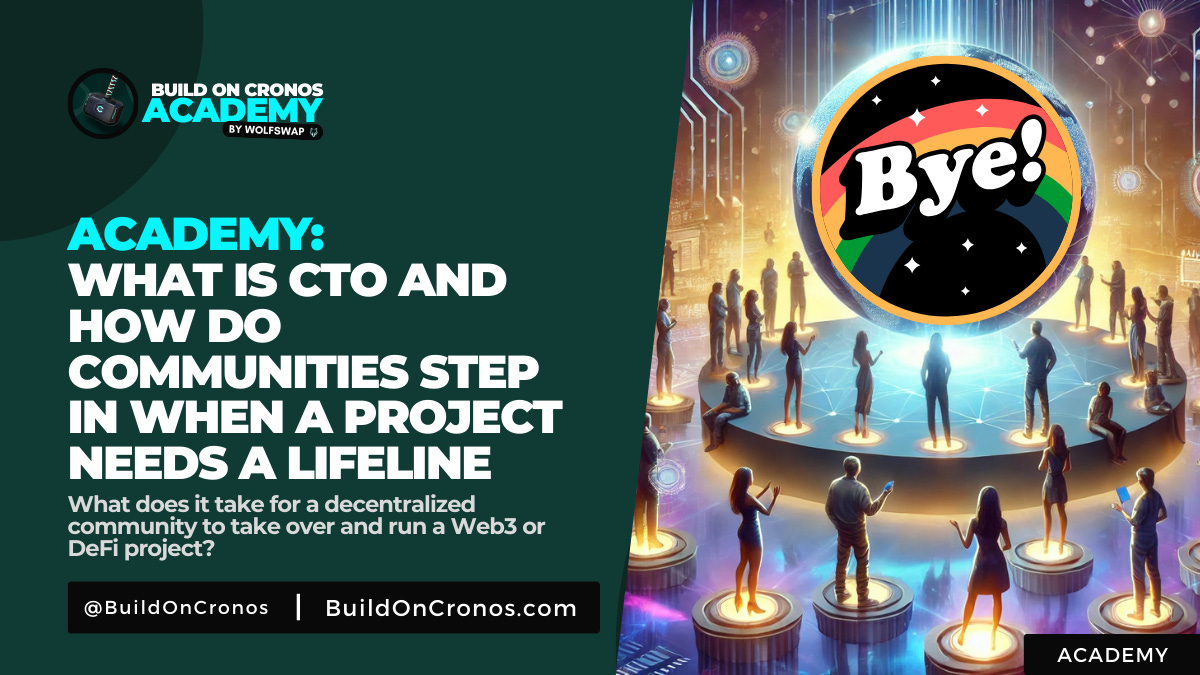What Is CTO and How Do Communities Step In When a Project Needs a Lifeline
What does it take for a decentralized community to take over and run a Web3 or DeFi project?
A Community Takeover, or CTO, is a fascinating process where the users and supporters of a Web3 project collectively step in to take control of its future. This phenomenon is a true embodiment of decentralized principles, showcasing the power of community-driven decision-making.
In this article, we’ll explore:
What a CTO is and why it happens?
The mechanics of a CTO
Challenges and opportunities for projects undergoing a CTO
By the end of this guide, you'll have a clear understanding of CTOs' role in the web3 space and why they are part of the Web3 space on regular basis.
What is a Community Takeover?
ELI5 Explanation
Imagine your favorite café owner decides to retire, but instead of shutting down, the regular customers come together, pool their resources, and run the café themselves. That’s a CTO in the Web3 world.
It’s when the community—the project’s users, developers, and supporters—takes control of a project that is at risk of abandonment, mismanagement, or closure.
Deep Dive
A CTO happens in decentralized projects when the original team steps back due to reasons like lack of funding, burnout, shifting priorities, or simply abandonment of the project. The community, valuing the project’s potential, assumes control of operations, governance, and decision-making.
In Web3, this transition is possible because many projects are built on open-source protocols. This means anyone with the technical know-how can access the project’s smart contracts, codebase, and governance structures. CTOs are a testament to the resilience and decentralized nature of blockchain ecosystems.
How Does a CTO Work?
ELI5 Explanation
Think of it like a group project where no one’s officially in charge anymore. The group (community) has to decide who does what—who handles the finances, makes the rules, and ensures everything runs smoothly.
Deep Dive
The mechanics of a CTO involve several key steps:
Identifying the Need: The community recognizes the original team is stepping back or failing to deliver.
Organizing Governance: A decentralized governance system is put in place, often using tools like DAOs (Decentralized Autonomous Organizations).
Taking Control: Community members may fork the project, manage the treasury, or assume development responsibilities.
Sustaining the Project: The community creates new incentives to attract developers, users, and investors.
Key tools include multi-signature wallets for treasury management, token-weighted voting for decisions, and collaboration platforms like Discord and Snapshot.
Why Do CTOs Happen?
ELI5 Explanation
Sometimes, the original owners of a project can’t or don’t want to keep running it. Instead of letting the project disappear, the community takes over because they still believe in it.
Deep Dive
Common reasons for a CTO include:
Project Abandonment: The team disbands or loses interest.
Mismanagement: Poor decision-making leads to a lack of trust.
Funding Shortages: Insufficient capital to continue operations.
Market Interest: The community sees untapped potential and wants to revive the project.
Projects undergoing CTOs often already have strong community backing and a clear use case, making them worth saving.
Challenges and Opportunities in CTOs
ELI5 Explanation
Running a project isn’t easy. The community has to deal with growing pains, like figuring out who’s in charge of what, keeping the project funded, and making sure everyone agrees on the rules.
Deep Dive
Challenges:
Coordination Issues: Decentralized teams can struggle with decision-making and execution.
Skill Gaps: Not all community members have the technical or managerial expertise needed.
Funding Needs: Sustaining operations requires resources, which may not be immediately available.
Opportunities:
True Decentralization: CTOs align with the ethos of blockchain by empowering communities.
Renewed Vision: Fresh ideas and enthusiasm often emerge from a motivated community.
Innovation Potential: Decentralized teams may experiment with governance models or tokenomics improvements.
Why CTOs Matter in Web3 and DeFi
CTOs are more than just a safety net for struggling projects—they’re proof that Web3 is built on resilient, decentralized principles. They give power to the people, ensuring valuable projects don’t fade into obscurity.
Conclusion
Whether you’re a builder, investor, or active community member, understanding the dynamics of a CTO can help you navigate opportunities and challenges in the DeFi ecosystem.
Ready to dive deeper? Explore more at Build On Cronos Academy!






